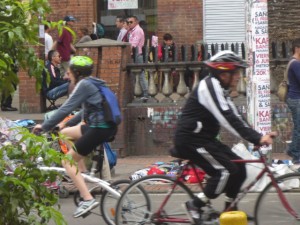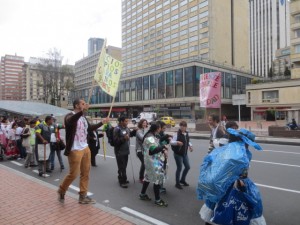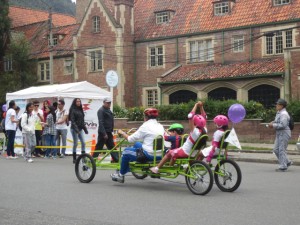 This interesting article in The Guardian just came across my transom. It’s about anthropological research that scrutinizes Bogotá’s apparent urban transformation during the past twenty years by looking critically at the gap between how the story has been sold internationally and on-the-ground realities in Bogotá, where much of the bally-hooed change has either not materialized, or just reinforced certain pre-existing social hierarchies. It’s a theme that aligns closely with my own research, though my ethnographic focus is distinct.
This interesting article in The Guardian just came across my transom. It’s about anthropological research that scrutinizes Bogotá’s apparent urban transformation during the past twenty years by looking critically at the gap between how the story has been sold internationally and on-the-ground realities in Bogotá, where much of the bally-hooed change has either not materialized, or just reinforced certain pre-existing social hierarchies. It’s a theme that aligns closely with my own research, though my ethnographic focus is distinct.
As I was leaving Bogotá to return to the U.S. back in late-June, one of my anthropology colleagues at the Universidad Nacional told me about a book project she was working on with a similar critical focus and she invited me to make my own contribution. Getting to our meeting had been a bit of an ordeal as my cheap Colombian bicycle, perhaps sensing that I would soon be abandoning it, decided to go haywire on me. Crossing through an intersection three or four spokes shot out of the rear wheel, one of them right into my tire, resulting in a quickly flattening tire, and–somehow–generating one of the worst chain sucks I’ve ever witnessed. I’m a handy bike mechanic but it took me a good twenty minutes to massage–and strong arm–the bike back into useable shape with no tools, and we limped to the meeting (very late now) with me covered in grease and nasty Bogotá street grime.
 After my profuse apologies and efforts to not get grease all over the chair I was sitting in, she explained that the project she was working on examines how Colombia’s declining homicide rates, new constitutional protections of ethnic rights, its initiatives to demobilize paramilitaries, and its efforts at urban renewal have become the basis of a widely-circulating narrative, promoted by the U.S. and Colombian governments and media outlets throughout North America and Europe, of Colombia as a model for successful policy innovation. The way the narrative had been constructed and circulated, she argued, had greatly oversimplified some incredibly complex and unfinished dynamics that were still playing out. A point anthropologists often make, and it was hers too, is that “innovative” policy solutions don’t enter into historical, political-economic, and cultural vaccuums, and in fact the dynamics associated with these domains continue to shape the social field as well as the ways these policies are interpreted and implemented. It captivated me immediately because it was this very narrative of Bogotá as innovative bicycle city that I had come to scrutinize.
After my profuse apologies and efforts to not get grease all over the chair I was sitting in, she explained that the project she was working on examines how Colombia’s declining homicide rates, new constitutional protections of ethnic rights, its initiatives to demobilize paramilitaries, and its efforts at urban renewal have become the basis of a widely-circulating narrative, promoted by the U.S. and Colombian governments and media outlets throughout North America and Europe, of Colombia as a model for successful policy innovation. The way the narrative had been constructed and circulated, she argued, had greatly oversimplified some incredibly complex and unfinished dynamics that were still playing out. A point anthropologists often make, and it was hers too, is that “innovative” policy solutions don’t enter into historical, political-economic, and cultural vaccuums, and in fact the dynamics associated with these domains continue to shape the social field as well as the ways these policies are interpreted and implemented. It captivated me immediately because it was this very narrative of Bogotá as innovative bicycle city that I had come to scrutinize.
 So with her invitation to think more deeply about this issue, here’s what I’m working on now:
So with her invitation to think more deeply about this issue, here’s what I’m working on now:
During the 7th World Urban Forum of 2014, Bogotá received a coveted Urban Sustainability prize, recognized for its initiatives to lower water and energy consumption, promote the use of recycled construction materials, and strengthen non-motorized transportation through the addition of new lanes to its already expansive network of bicycle lanes and tracks. Bogotá’s image as a global beacon of transportation sustainability, in particular, has circulated widely during the past decade, in part thanks to the abilities former mayors Antanas Mockus and Enrique Peñalosa have had to communicate on a global stage their administrations’ urban revitalization and alternative transportation initiatives between 1994 and 2003.
In those initiatives, the bicycle was singled out as a protagonist in constructing a new “citizen culture” and in enabling all citizens, regardless of socio-economic status, to have equal right to the city. The expansion of the city’s weekly ciclovía events and the creation of the largest bicycle network in the Americas has generated interest among northern audiences and urban leaders struggling with their own problems of mobility, and led the BBC in 2011 to declare Bogotá a “biking paradise.” But during the past decade, even as more people have taken to the bicycle as an everyday mode of transportation in Bogotá, successive city administrations have ignored or downplayed the bicycle as a priority in dealing with the city’s ongoing mobility problems, and huge numbers of people continue to express skepticism about bicycles as a viable transportation option.
In response to poorly-designed and now crumbling infrastructure, many bicycle riders express a strong sense that the “golden years” are over, and the city is experiencing the rise of an increasingly assertive citizen bicycle advocacy sector struggling to communicate the relevance of the bicycle to a skeptical public and policymakers. This paper, which is based on ethnographic fieldwork among Bogotá bicycle advocates and city officials involved in bicycle mobility issues, explores why so many Bogotanos themselves problematize the image of the city as a biking paradise, the reasons the image still circulates transnationally, and the quotidian struggles involved in constructing a new bicycle culture and politics in the city.